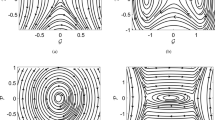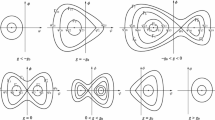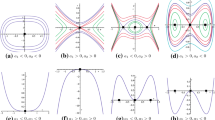Abstract
The Maslov index is a powerful tool for assessing the stability of solitary waves. Although it is difficult to calculate in general, a framework for doing so was recently established for singularly perturbed systems (Cornwell and Jones in SIAM J Appl Dyn Syst 17(1):754–787, 2018). In this paper, we apply this framework to standing wave solutions of a three-component activator-inhibitor model. These standing waves are known to become unstable as parameters vary. Our goal is to see how this established stability criterion manifests itself in the Maslov index calculation. In so doing, we obtain new insight into the mechanism for instability. We further suggest how this mechanism might be used to reveal new instabilities in singularly perturbed models.


Similar content being viewed by others
Notes
For a proof that \(E^{s/u}(\lambda ,\xi )\) are Lagrangian subspaces for fixed \(\lambda \ge 0\) and \(\xi \in {\mathbb {R}}\), see [13, Theorem 2.3].
This is true specifically for the second corner, which is the transition from the first slow segment to the fast back. Although multiple heteroclinic connections exist at the other two corners as well, neither path taken would result in a conjugate point.
References
Alexander, J., Gardner, R.A., Jones, C.K.R.T.: A topological invariant arising in the stability analysis of travelling waves. J. Reine Angew. Math. 410(167–212), 143 (1990)
Arnol’d, V.I.: Characteristic class entering in quantization conditions. Funct. Anal. Appl. 1(1), 1–13 (1967)
Beck, M., Cox, G., Jones, C., Latushkin, Y., McQuighan, K., Sukhtayev, A.: Instability of pulses in gradient reaction-diffusion systems: A symplectic approach. Philos. Trans. R. Soc. A 376(2117), 20170187 (2018)
Bose, A., Jones, C.K.R.T.: Stability of the in-phase travelling wave solution in a pair of coupled nerve fibers. Indiana Univ. Math. J. 44(1), 189–220 (1995)
Brunovskỳ, P.: Tracking invariant manifolds without differential forms. Acta Math. Univ. Comen. 65(1), 23–32 (1996)
Brunovskỳ, P.: \({C}^r\)-inclination theorems for singularly perturbed equations. J. Differ. Equ. 155(1), 133–152 (1999)
Carter, P., Rademacher, J.D., Sandstede, B.: Pulse replication and accumulation of eigenvalues. arXiv preprint arXiv:2005.11683 (2020)
Chardard, F., Dias, F., Bridges, T.J.: Computing the Maslov index of solitary waves, part 1: Hamiltonian systems on a four-dimensional phase space. Phys. D Nonlinear Phenom. 238(18), 1841–1867 (2009)
Chardard, F., Dias, F., Bridges, T.J.: On the Maslov index of multi-pulse homoclinic orbits. Proc. R. Soc. A Math. Phys. Eng. Sci. 465(2109), 2897–2910 (2009)
Chen, C.-N., Choi, Y.S.: Standing pulse solutions to FitzHugh–Nagumo equations. Arch. Ration. Mech. Anal. 206(3), 741–777 (2012)
Chen, C.-N., Hu, X.: Maslov index for homoclinic orbits of Hamiltonian systems. Ann. I. H. Poincaré-AN. 24(4), 589–603 (2007)
Chen, C.-N., Xijun, H.: Stability analysis for standing pulse solutions to FitzHugh–Nagumo equations. Calc. Var. Partial Differ. Equ. 49(1–2), 827–845 (2014)
Cornwell, P.: Opening the Maslov box for traveling waves in skew-gradient systems: counting eigenvalues and proving (in) stability. Indiana Univ. Math. J. 68(6), 1801–1832 (2019)
Cornwell, P., Jones, C.K.R.T.: On the existence and stability of fast traveling waves in a doubly diffusive FitzHugh–Nagumo system. SIAM J. Appl. Dyn. Syst. 17(1), 754–787 (2018)
Doelman, A., Van Heijster, P., Kaper, T.J.: Pulse dynamics in a three-component system: existence analysis. J. Dyn. Differ. Equ. 21(1), 73–115 (2009)
Dumortier, F.: Techniques in the theory of local bifurcations: blow-up, normal forms, nilpotent bifurcations, singular perturbations. In: Bifurcations and Periodic Orbits of Vector Fields, pp. 19–73. Springer (1993)
Fenichel, N.: Geometric singular perturbation theory for ordinary differential equations. J. Differ. Equ. 31(1), 53–98 (1979)
Hatcher, A.: Algebraic Topology. Cambridge University Press, Cambridge (2002)
Henry, D.: Geometric Theory of Semilinear Parabolic Equations. Lecture Notes in Mathematics. Springer, Berlin (1981)
Howard, P., Latushkin, Y., Sukhtayev, A.: The Maslov and Morse indices for Schrödinger operators on \({\mathbb{R}}\). Indiana Univ. Math. J. 67(5), 1765–1815 (2018)
Jones, C.: Geometric singular perturbation theory. In: Dynamical Systems, pp. 44–118 (1995)
Jones, C., Latushkin, Y., Sukhtaiev, S.: Counting spectrum via the Maslov index for one dimensional \(\theta \)-periodic Schrödinger operators. Proc. Am. Math. Soc. 145(1), 363–377 (2017)
Jones, C.K.R.T.: Instability of standing waves for non-linear Schrödinger-type equations. Ergod. Theory Dyn. Syst. 8(8), 119–138 (1988)
Jones, C.K.R.T., Latushkin, Y., Marangell, R.: The Morse and Maslov indices for matrix Hill’s equations. In: Spectral Analysis, Differential Equations and Mathematical Physics: A Festschrift in Honor of Fritz Gesztesy’s 60th Birthday, vol. 87, pp. 205–233 (2013)
Jones, C.K.R.T., Kopell, N.: Tracking invariant manifolds with differential forms in singularly perturbed systems. J. Differ. Equ. 108(1), 64–88 (1994)
Kuehn, C.: Multiple Time Scale Dynamics, vol. 191. Springer, Berlin (2015)
Milnor, J.W.: Morse Theory. Princeton University Press, Princeton (1963)
Robbin, J., Salamon, D.: The Maslov index for paths. Topology 32(4), 827–844 (1993)
Sandstede, B.: Stability of Travelling Waves. Handbook of Dynamical Systems, vol. 2, pp. 983–1055 (2002)
Schenk, C.P., Or-Guil, M., Bode, M., Purwins, H.-G.: Interacting pulses in three-component reaction-diffusion systems on two-dimensional domains. Phys. Rev. Lett. 78(19), 3781 (1997)
van Heijster, P., Chen, C.-N., Nishiura, Y., Teramoto, T.: Localized patterns in a three-component FitzHugh–Nagumo model revisited via an action functional. J. Dyn. Differ. Equ. 30(2), 521–555 (2018)
van Heijster, P., Doelman, A., Kaper, T.J.: Pulse dynamics in a three-component system: stability and bifurcations. Phys. D Nonlinear Phenom. 237(24), 3335–3368 (2008)
Yanagida, E.: Mini-maximizers for reaction-diffusion systems with skew-gradient structure. J. Differ. Equ. 179(1), 311–335 (2002)
Yanagida, E.: Standing pulse solutions in reaction-diffusion systems with skew-gradient structure. J. Dyn. Differ. Equ. 14(1), 189–205 (2002)
Acknowledgements
C.J. acknowledges support from the US Office of Naval Research under Grant Number N00014-18-1-2204.
Author information
Authors and Affiliations
Corresponding author
Additional information
Publisher's Note
Springer Nature remains neutral with regard to jurisdictional claims in published maps and institutional affiliations.
Rights and permissions
About this article
Cite this article
Cornwell, P., Jones, C.K.R.T. & Kiers, C. Bifurcation to Instability Through the Lens of the Maslov Index. J Dyn Diff Equat 36 (Suppl 1), 127–148 (2024). https://doi.org/10.1007/s10884-021-10017-1
Received:
Revised:
Accepted:
Published:
Issue Date:
DOI: https://doi.org/10.1007/s10884-021-10017-1




